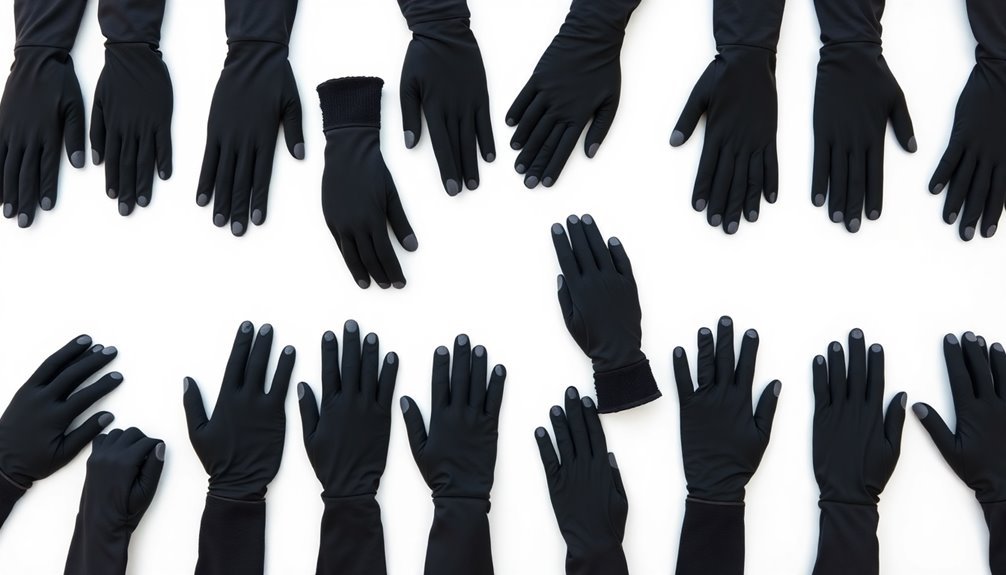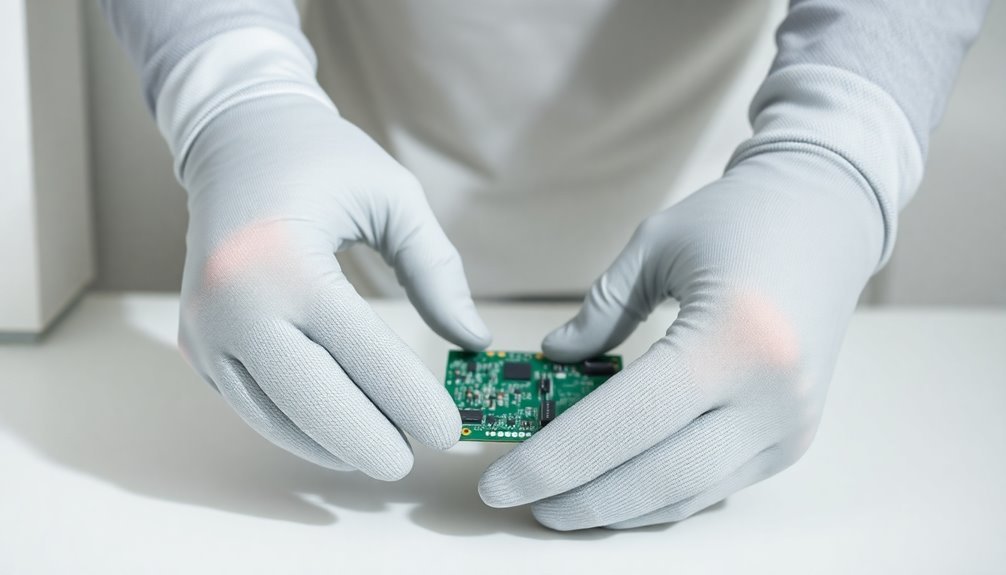You'll find excellent ESD protection with ThxToms Anti Static Gloves, known for their dense carbon fiber and ergonomic design. For PC building, consider the lightweight Anti Static Work Gloves or the durable ESD-Safe Cut Resistant option that comes with 10 pairs. The 4-pair ESD Anti Static set offers great value, while JDL's 12-pair pack provides long-term reliability. Portwest A198's fingertip design guarantees precision, Safety ESD's 12-pair bundle delivers cost-effectiveness, and VIPER's gloves excel in comfort. Let's explore how these top choices can protect your sensitive electronics and improve your workflow.
ThxToms ESD Anti Static Gloves for Computer Work

ThxToms ESD Anti Static Gloves are perfect for tech enthusiasts and professionals who handle sensitive electronic components regularly. These carbon fiber gloves effectively prevent static discharge while providing excellent dexterity for intricate tasks like PC assembly and phone repairs.
You'll appreciate the ergonomic palm design and polyurethane-coated fingers that enhance grip and precision. The dense carbon fiber material eliminates the need for a separate wrist strap, making these gloves a practical all-in-one solution. With dimensions of 3.15 x 1.57 x 0.39 inches and weighing just 0.64 ounces, they're lightweight and comfortable for extended use.
While they might not work well with touchscreens, users consistently praise their effectiveness in preventing static shocks. The gloves have earned a solid 4.3-star rating from 1,449 customers, confirming their reliability for electronics handling and even vinyl record maintenance.
Best For: Electronics enthusiasts, computer technicians, and DIY repair professionals who regularly work with sensitive electronic components and need reliable static protection while maintaining finger dexterity.
Pros:
- Effective static discharge protection with dense carbon fiber material eliminates need for separate wrist strap
- Ergonomic design with polyurethane-coated fingers provides excellent grip and precision for detailed work
- Lightweight and comfortable for extended use, with positive feedback for electronics and vinyl record handling
Cons:
- Not compatible with touchscreen devices
- Sizing runs small and may require ordering a larger size than usual
- Some users report room for improvement in overall comfort and quality
Anti Static Work Gloves for PC Building (2 Pairs)
Building PCs with vintage components or sensitive electronics? These anti-static work gloves come in a convenient two-pair pack and effectively protect your components from static electricity damage. Users working with computer boards from the 80s and 90s have reported successful static-free handling.
You'll find these gloves comfortable and breathable, preventing sweaty hands during extended work sessions. They're versatile enough for various tasks, from mail handling to laptop repairs. While the thin, lightweight design allows for precise movements, you'll need to be careful around sharp pins and edges, as durability isn't their strongest feature.
Despite rare reports of static zaps, these gloves have proven reliable for their intended purpose. If you're handling sensitive electronics regularly, you'll appreciate their effectiveness in preventing static discharge while maintaining good dexterity.
Best For: Electronics enthusiasts, PC builders, and technicians who regularly handle static-sensitive components and need reliable protection while maintaining dexterity.
Pros:
- Effectively prevents static electricity damage to sensitive electronic components
- Comfortable fit with breathable material that prevents hand sweating
- Comes in a convenient two-pair pack for backup or sharing
Cons:
- Limited durability with potential for snagging on sharp edges
- Occasional reports of static zaps despite protection
- Thin material may not provide adequate protection against physical hazards
ESD-Safe Cut Resistant Anti-Static Gloves (10 Pairs)

Professionals working with sensitive electronics and sharp materials will find these ESD-safe cut-resistant gloves indispensable. Made with high-performance Dyneema material, these gloves offer exceptional dexterity while protecting you from cuts and static discharge.
The polyurethane palm coating provides excellent grip, while the carbon yarn knit guarantees reliable anti-static properties. You'll appreciate the gloves' ability to prevent lint and particulate contamination, making them perfect for clean room environments and sensitive electronics handling.
Whether you're building PCs, handling circuit boards, or working with glass, these gloves deliver the protection you need. With 10 pairs included, you'll have plenty of replacements on hand. The combination of cut resistance and ESD safety makes these gloves a smart choice for electronics manufacturing, assembly, and maintenance tasks.
Best For: Electronics technicians, manufacturing workers, and assembly line professionals who need protection from both static discharge and sharp objects while maintaining manual dexterity.
Pros:
- Superior cut resistance with Dyneema material provides excellent protection when handling sharp components
- Anti-static properties make them safe for working with sensitive electronic components
- Low-lint design and contamination control make them suitable for clean room environments
Cons:
- Higher cost compared to standard work gloves due to specialized materials
- May require periodic replacement due to wear and tear of the polyurethane coating
- Some users might need time to adjust to the snug fit required for proper ESD protection
ESD Anti Static Gloves for PC Building and Electronics (4 Pairs)
Working with sensitive electronic components demands reliable static protection, and these ESD anti-static gloves deliver with their carbon fiber lining and conductive properties. You'll get four pairs of medium-sized gloves, featuring a micro-foamed polyurethane coating that guarantees a nonslip grip during delicate assembly tasks.
The braided wrist design keeps dust and debris out while you're working on PCs, electronics, or jewelry. They're made of nylon with conductive carbon and offer lightweight flexibility that's essential for precise work. While customer experiences vary, with some praising their effectiveness for handling delicate items and others noting size limitations, these gloves serve their primary purpose of static protection. Just keep in mind there might be slight size variations due to manual measurement, and the color may differ slightly from what you see online.
Best For: Electronics enthusiasts, PC builders, and repair technicians who need reliable static protection while handling sensitive components and performing detailed assembly work.
Pros:
- Comes with 4 pairs of gloves, providing good value and backup options
- Carbon fiber lining and conductive properties offer essential static protection
- Nonslip polyurethane coating ensures secure grip during delicate work
Cons:
- Limited size options with only medium size available
- Some users report durability concerns
- Potential sizing inconsistencies due to manual measurement variations
JDL ESD Anti-Static Work Gloves for PC Building (12 Pairs)

Safety meets precision with JDL's ESD Anti-Static Work Gloves, a 12-pair set designed for meticulous PC builders and electronics enthusiasts. These gloves feature high-resistance carbon fiber and a 13-gauge seamless knit with PU coating, ensuring both anti-static protection and tactile sensitivity.
You'll appreciate the polyurethane finger coating that provides excellent grip while maintaining accuracy for delicate tasks. The ergonomic design reduces hand fatigue during extended work sessions, making them ideal for PC assembly, phone repairs, and laboratory work. They're lightweight and stretchy for a comfortable fit.
To maintain their effectiveness, you can wash these gloves in warm water (up to 104℉) with mild detergent. They're certified with CE, EN16350, UKCA, and OEKO-TEX standards, giving you confidence in their quality. The gloves come with Amazon's 30-day return guarantee, and additional warranty options are available.
Best For: PC builders, electronics repair technicians, and lab workers who need reliable anti-static protection while maintaining precise finger control and comfort during detailed work.
Pros:
- High-quality anti-static protection with dense carbon fiber construction
- Excellent tactile sensitivity with PU coating and 13-gauge seamless knit design
- Great value with 12 pairs included and comprehensive certification standards
Cons:
- Only available in large size, which may not fit all users
- Requires specific care instructions for washing and drying
- May need regular replacement due to wear from repeated use in precision work
Portwest A198 Antistatic PU Fingertip Glove Grey, Medium
The Portwest A198 Antistatic PU Fingertip Glove excels in electronics assembly and precision work where static discharge control is essential. You'll find these gloves meet rigorous standards, including EN1149-1 and EN1149-5 for ESD protection, while offering ANSI cut level A1 safety.
The gloves' blend of polyester, carbon fiber, and elastane provides durability and comfort, while the smooth PU coating enhances abrasion resistance. They've earned a solid 4.3-star rating from 228 users, though you might want to order a size up for the best fit. While most users praise their thinness and durability, some report mixed results with static reduction.
Coming from Portwest, a trusted name since 1904, these gloves reflect the company's commitment to quality workwear. You'll appreciate their versatility across various applications, from electronics testing to general precision tasks.
Best For: Electronics technicians, assembly line workers, and precision manufacturers who need reliable static control while maintaining finger dexterity and tactile sensitivity.
Pros:
- Meets multiple safety standards including EN1149-1 and EN1149-5 for ESD protection
- Thin and flexible design allows excellent dexterity for precise work
- Durable construction with PU coating for enhanced abrasion resistance
Cons:
- Some users report inconsistent effectiveness in static reduction
- May run small, requiring sizing up for optimal fit
- Limited color options available (grey only)
Safety ESD Anti Static Work Gloves (12 Pairs)

Professional electronics assemblers and PC builders will appreciate these 12 pairs of PU-coated anti-static gloves, specifically designed for handling sensitive electronic components. The PU coating covers the entire palm and fingers, providing enhanced grip for both large and small parts, while also protecting against sharp edges during tasks like 3D printing.
You'll want to size up when ordering these gloves, as they tend to run small, particularly in the Small and Medium sizes. While they're comfortable and cause minimal sweating during use, some users note they'd prefer a thicker material. The gloves come well-packaged in pairs and offer good durability for daily electronic assembly work. Though most users report positive experiences with grip and comfort, there have been occasional reports of static shocks, suggesting varying effectiveness in ESD protection.
Best For: Electronics assemblers, PC builders, and technicians who need reliable hand protection and anti-static properties while handling sensitive electronic components.
Pros:
- PU coating provides excellent grip for handling both large and small electronic parts
- Comfortable fit with minimal sweating during extended use
- Good value with 12 pairs packaged conveniently in sets of two
Cons:
- Sizing runs small, requiring most users to order one size up
- Some users report experiencing static shocks despite anti-static properties
- Material could be thicker for better durability and quality feel
VIPER Anti Static ESD Safety Work Gloves
Featuring coated fingertip carbon fibers, VIPER Anti Static ESD Safety Work Gloves offer versatile protection for both electronics enthusiasts and professionals who need reliable static control. You'll find these gloves suitable for various tasks, from oil painting to detailed electronics work, with their comfortable design making it easy to handle small items.
The gloves accommodate different hand sizes, though you'll want to note they might run small if you typically wear XL. They're reusable multiple times, helping reduce plastic waste while providing good value for the included pairs. You'll appreciate their warmth and comfort, especially if you have specific medical needs like managing temperature sensitivity during chemotherapy.
While some users find them too thin for complete static control, these reasonably priced gloves deliver reliable performance for most ESD-safe applications.
Best For: Electronics enthusiasts, detail workers, and individuals needing static protection who have small to medium-sized hands and require reliable ESD safety during precise tasks.
Pros:
- Comfortable design allows for easy handling of small items while maintaining static protection
- Reusable multiple times, making them environmentally friendly and cost-effective
- Versatile application for various tasks including electronics work and oil painting
Cons:
- Size runs small, particularly challenging for users who typically wear XL
- Some users report the gloves being too thin for complete static control
- May be too tight for those with larger hands, potentially limiting comfort during extended use
Factors to Consider When Choosing ESD-Safe Gloves

When you're selecting ESD-safe gloves, you'll need to evaluate critical factors like material composition, proper sizing, and static protection ratings to guarantee peak performance. You'll want to assess the gloves' grip characteristics and dexterity features, as these directly impact your ability to handle sensitive electronic components effectively. The durability and wear resistance of your chosen gloves will determine their longevity and cost-effectiveness in your ESD-protected workspace.
Material Composition and Quality
The material composition of ESD-safe gloves plays an essential role in their performance and reliability. When you're selecting gloves, you'll find that materials like carbon fiber, nylon, and polyurethane combine to create effective anti-static protection while maintaining comfort during use. The polyurethane coating on the fingers is particularly important, as it'll enhance your grip and precision when handling delicate electronic components.
You should look for gloves with a seamless knit design, which will provide you with a better fit and reduce hand fatigue during long periods of use. If you're working in environments where cut hazards are present, consider gloves made with Dyneema, which offers both anti-static properties and cut resistance for added safety.
The thickness and quality of the materials directly impact the gloves' durability. You'll want to invest in gloves made from higher-quality fabrics that can withstand demanding tasks. While they might cost more initially, thicker, premium materials will offer better protection and last longer, making them more cost-effective in the long run. Remember that superior material quality translates to better performance and reliability in your daily tasks.
Size and Fit Options
Beyond material selection, finding the right size and fit for your ESD-safe gloves will directly impact your work performance. When selecting your size, you'll need to take into account that many ESD gloves tend to run smaller than standard sizing, so you might need to order one size up from your usual preference. Even if gloves appear small due to their elastic design, don't automatically assume they won't fit – check the manufacturer's sizing charts carefully.
You'll want to verify your gloves provide enough flexibility for intricate electronics work while maintaining a snug fit. The braided wrist feature, which helps keep out dust and debris, can affect how the gloves feel on your hands, so factor this into your sizing decision. If possible, try on the gloves before purchasing, as fit experiences can vary greatly between brands and models.
Remember that proper sizing isn't just about comfort – it's essential for maintaining dexterity during precise tasks. When your gloves fit correctly, you'll be able to handle small components and perform detailed assembly work without restriction, ultimately improving your efficiency and reducing the risk of mistakes.
Static Protection Effectiveness
Selecting ESD-safe gloves requires careful attention to their static protection effectiveness, which varies considerably across different materials and designs. When you're evaluating static protection, you'll want to focus on the glove's material composition, with dense carbon fiber options providing superior static dissipation compared to basic alternatives.
Look for gloves that meet industry standards like EN1149-1 and EN1149-5, as these certifications guarantee reliable static electricity dispersion. Your work environment should guide your choice of protection level – if you're handling highly sensitive components, you'll need gloves with enhanced static protection capabilities.
The effectiveness of your ESD-safe gloves also depends on their fit. You'll compromise both protection and functionality if your gloves are too loose or tight. A proper fit guarantees consistent contact between the glove's conductive materials and your skin, maintaining ideal static dissipation. When choosing your gloves, consider materials like polyurethane or carbon fiber blends that offer reliable static protection while maintaining necessary dexterity. Remember that different electronic components may require varying levels of protection, so match your glove's static dissipation capabilities to your specific application needs.
Grip and Dexterity Level
Building on proper static protection, grip and dexterity capabilities determine how effectively you'll perform tasks while wearing ESD-safe gloves. The polyurethane coatings commonly found on these gloves provide excellent traction, letting you handle delicate electronic components and tools with confidence. When selecting your gloves, look for designs featuring ergonomic palm shapes and thin materials that maximize your ability to perform fine motor tasks.
High-resistance carbon fiber materials offer an ideal balance of anti-static protection and flexibility, ensuring you won't sacrifice movement for safety. You'll find that properly sized gloves are essential – they should fit snugly without excess material that could interfere with your work. If your gloves are too loose or tight, they'll compromise both your grip and manual dexterity.
For tasks requiring exceptional precision, consider gloves with coated fingertips. These specialized designs enhance tactile feedback, letting you feel and manipulate static-sensitive components with greater accuracy. Remember that your ability to maintain a secure grip while performing detailed work directly impacts both efficiency and the safety of sensitive electronic components.
Durability and Wear Resistance
Your investment in ESD-safe gloves hinges heavily on their durability and wear resistance, as these factors directly impact both protection levels and cost-effectiveness over time. When selecting ESD gloves, you'll want to focus on materials like Dyneema or carbon fiber, which have proven track records for maintaining their structural integrity during extended use.
Pay close attention to the coating type, as polyurethane or rubber coatings greatly enhance the gloves' longevity through superior abrasion resistance. You'll find that these protective layers help prevent premature wear, especially when handling components with sharp edges that might otherwise damage the gloves.
To maximize your gloves' lifespan, you'll need to implement proper care routines. Avoid exposing them to high temperatures during washing or drying, as this can compromise their anti-static properties. Regular maintenance, including gentle washing when needed, helps preserve both the physical structure and ESD-protective qualities of the gloves.
Remember that while some gloves might seem cost-effective initially, their true value lies in how well they maintain their protective properties over time. Look for options that balance immediate performance with long-term durability to guarantee consistent ESD protection throughout their service life.
Workplace Safety Compliance
Three vital safety standards govern the selection of ESD-safe gloves in modern workplaces: EN16350, IEC 61340-5-1, and facility-specific requirements. You'll need to guarantee your chosen gloves meet these standards to maintain a safe working environment and protect sensitive electronic components from static discharge damage.
When evaluating compliance, you must verify the gloves' material composition includes appropriate conductive elements and carbon fibers that effectively dissipate static electricity. Regular testing of your ESD-safe gloves isn't optional – it's an essential part of maintaining workplace safety standards. You should implement a testing schedule to confirm the gloves continue meeting anti-static specifications throughout their service life.
Don't overlook the importance of proper sizing in compliance. Your ESD-safe gloves must fit correctly to maintain their protective properties and allow workers to perform precise tasks safely. You'll need to provide thorough training to your staff on proper glove usage, care, and maintenance procedures. This training should cover how to inspect gloves for damage, when to replace them, and proper wearing techniques to guarantee consistent protection against electrostatic discharge in your sensitive work areas.
Price Vs Quantity Value
Smart shoppers know that balancing price against quantity is vital when investing in ESD-safe gloves. You'll want to carefully evaluate the cost per pair, especially when reflecting on bulk purchases that often provide better value for regular use. Buying packs of 10 or more pairs can greatly reduce your per-unit cost, making them more economical if you're using them frequently.
While you might be tempted to opt for the cheapest gloves available, it's important to contemplate the long-term implications of your purchase. Lower-quality gloves may need more frequent replacement, which can drive up your overall costs. Premium-priced gloves often justify their higher cost through superior durability and better protection for sensitive electronic components, potentially saving you money by preventing costly static damage.
To determine the best value, you'll need to calculate the total cost effectiveness by examining both the price point and quantity offered in each package. Don't forget to factor in your usage frequency and replacement needs. This thorough approach will help you make an informed decision that balances immediate costs with long-term value.
Environmental Working Conditions
Beyond budget considerations, selecting ESD-safe gloves requires careful attention to your working environment. You'll need to assess the humidity levels in your workspace, as this directly impacts static generation and discharge properties. If you're working in conditions with varying moisture levels, choose gloves that maintain their ESD protection across different humidity ranges.
For cleanroom operations, you'll want gloves that don't shed particles or generate lint, protecting sensitive components from contamination. Consider your workspace temperature too – if you're in a warm environment, opt for breathable materials that keep your hands comfortable during extended use. The lighting in your work area plays an essential role; you'll need gloves that provide enough tactile sensitivity and grip to handle small components precisely under various lighting conditions.
Don't forget to evaluate additional environmental hazards. If you're working with chemicals or sharp objects, you'll need gloves that combine ESD protection with chemical or cut resistance. Make sure the gloves you select meet all your environmental safety requirements while maintaining their electrostatic discharge protection properties.
Frequently Asked Questions
Can Esd-Safe Gloves Be Washed and Reused Multiple Times?
You can wash and reuse most ESD-safe gloves multiple times, but you'll need to test them after each wash to guarantee they maintain their static-dissipative properties. Regular washing may reduce their protective effectiveness.
Do ESD Gloves Expire or Lose Their Anti-Static Properties Over Time?
Yes, your ESD gloves will gradually lose their anti-static properties over time, especially with regular use and washing. You'll notice reduced effectiveness after about 6-12 months, depending on usage and storage conditions.
Are ESD Gloves Effective When Working With Liquid Cooling Systems?
You shouldn't use ESD gloves with liquid cooling systems. They're designed for static protection, not liquid exposure. Instead, use waterproof nitrile or neoprene gloves when handling coolants to guarantee proper protection.
Can You Use Touchscreen Devices While Wearing Esd-Safe Gloves?
You can use touchscreens while wearing some ESD-safe gloves, but it depends on the model. Look for gloves specifically labeled as "touchscreen compatible" or those with conductive fingertips for the best results.
What Temperature Range Can Esd-Safe Gloves Safely Operate In?
You'll find most ESD-safe gloves work well between -20°C to 60°C (-4°F to 140°F). However, check your specific glove's rating, as temperature ranges can vary by manufacturer and material composition.
In Summary
You'll find that selecting the right ESD-safe gloves comes down to your specific needs. Consider the grip level, durability, comfort, and quantity in each pack. Don't forget to check the size options and coating type, as these factors directly impact your work efficiency. Whether you're building PCs or handling sensitive electronics, investing in quality ESD protection is essential for preventing costly damage.





Leave a Reply